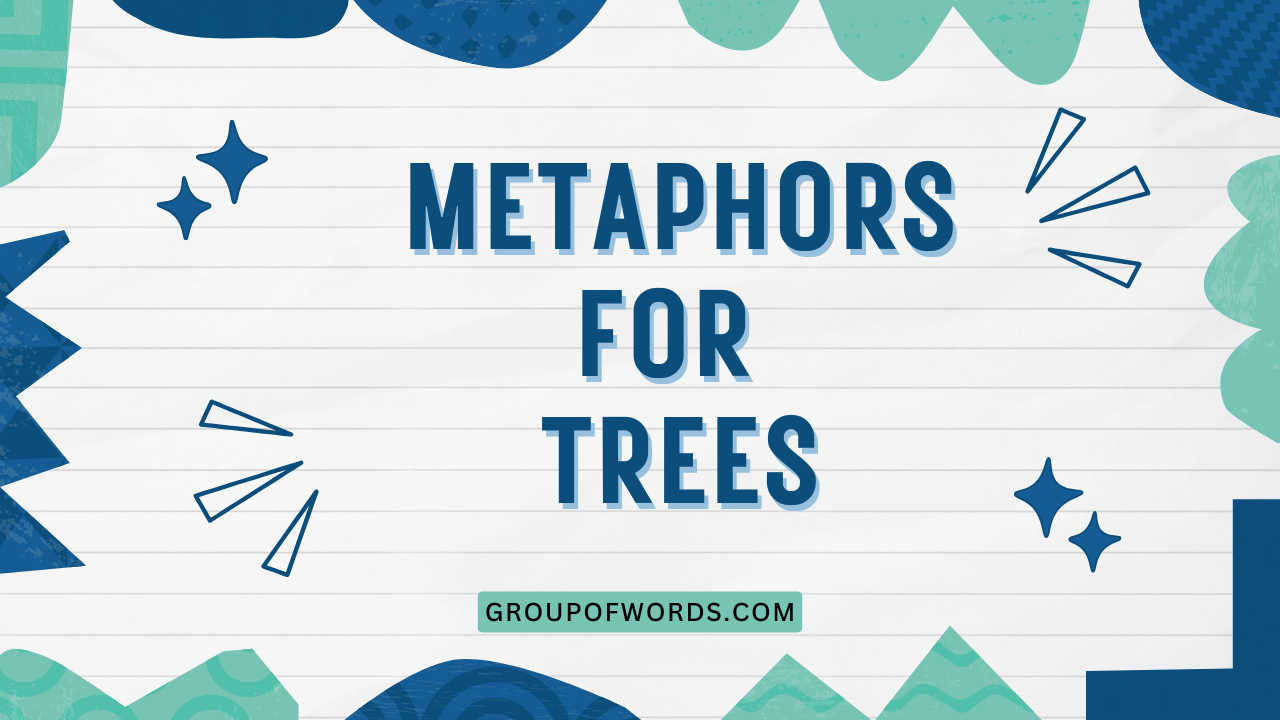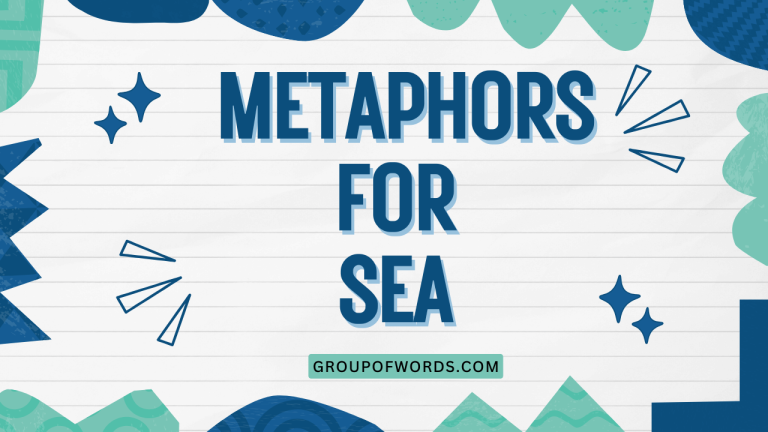Branching Out: Mastering Metaphors for Trees in English
Metaphors are powerful tools in the English language, adding depth and color to our communication. When we use metaphors for trees, we tap into a rich vein of symbolism and imagery.
Understanding these metaphors not only enhances our comprehension of literature and poetry but also improves our ability to express ourselves more creatively and effectively. This article provides a comprehensive guide to metaphors for trees, exploring their various types, usages, and the nuances they bring to language.
This is beneficial for students, teachers, writers, and anyone looking to enrich their understanding and use of the English language.
This article is designed to provide a clear understanding of metaphors for trees, equipping you with the knowledge and skills to identify and use them effectively. From basic definitions to advanced applications, we’ll cover everything you need to know.
Let’s delve into the world of metaphorical trees and discover the beauty and power they hold.
Table of Contents
- Introduction
- Definition of Metaphor
- Tree Symbolism
- Structural Breakdown of Tree Metaphors
- Types of Tree Metaphors
- Examples of Tree Metaphors
- Usage Rules for Tree Metaphors
- Common Mistakes with Tree Metaphors
- Practice Exercises
- Advanced Topics in Tree Metaphors
- Frequently Asked Questions
- Conclusion
Definition of Metaphor
A metaphor is a figure of speech that directly compares two unrelated things, asserting that one thing is another to suggest a likeness or analogy between them. Unlike similes, which use words like “like” or “as” to make a comparison, metaphors make a direct identification. This creates a more vivid and imaginative connection in the reader’s mind.
In the context of grammar, understanding metaphors is crucial because they significantly impact sentence structure and meaning. A well-crafted metaphor can transform a simple statement into a powerful and evocative expression, enriching the text and engaging the audience.
Metaphors function as a form of figurative language, adding layers of meaning beyond the literal interpretation of words.
Metaphors can be classified based on their explicitness. Explicit metaphors directly state the comparison, while implicit metaphors imply the comparison without directly stating it. The function of a metaphor is to create a connection that highlights specific qualities or characteristics of the compared items, offering new insights and perspectives. They are found in various contexts, including literature, poetry, everyday conversation, and even scientific writing.
Tree Symbolism
Trees have long held symbolic significance across various cultures and throughout history. Understanding this inherent symbolism is crucial for grasping the power and depth of tree metaphors.
Trees often represent life, growth, and the interconnectedness of all things. Their roots symbolize grounding and ancestry, while their branches reach towards the sky, representing aspiration and connection to the divine.
Different types of trees carry different symbolic meanings. For example, the oak tree often symbolizes strength, resilience, and longevity, while the willow tree is associated with mourning, flexibility, and adaptability.
The evergreen tree represents immortality and enduring life, and the blossoming cherry tree signifies beauty, renewal, and the fleeting nature of time.
In many cultures, trees are seen as sacred entities, representing the world tree or the axis mundi, the center of the world connecting heaven and earth. This deep-rooted symbolism makes trees a potent and versatile source of metaphorical imagery, allowing writers and speakers to tap into a wealth of associations and emotions.
By understanding the cultural and historical significance of trees, we can better appreciate the nuances and impact of tree metaphors.
Structural Breakdown of Tree Metaphors
The structure of a tree metaphor typically involves two main components: the tenor and the vehicle. The tenor is the subject being described, and the vehicle is the tree or tree-related concept used to describe it. The metaphor works by transferring qualities or characteristics from the vehicle to the tenor.
For example, in the metaphor “He is the oak of our family,” the tenor is “He,” and the vehicle is “oak.” The qualities of strength and stability associated with the oak tree are transferred to the person being described. This structure allows for a concise and impactful way to convey meaning.
The effectiveness of a tree metaphor depends on the clarity and relevance of the connection between the tenor and the vehicle. A strong metaphor creates a vivid image and conveys a deeper understanding of the subject.
The structural elements of a tree metaphor also include the context in which it is used. The surrounding sentences and the overall tone of the text can influence the interpretation and impact of the metaphor.
Types of Tree Metaphors
Personification
Personification is a type of metaphor where human qualities or characteristics are attributed to inanimate objects or abstract concepts. In the context of tree metaphors, personification involves giving trees human-like actions, emotions, or thoughts.
This can create a more engaging and relatable image for the reader.
For example, “The willow wept in the wind” is an example of personification. The act of weeping, typically associated with human sadness, is attributed to the willow tree. This creates a sense of melancholy and vulnerability. Personification can also be used to convey other emotions or actions, such as “The ancient oak stood guard over the forest,” which suggests protection and wisdom.
Personifying trees can add depth and emotional resonance to writing, making it more vivid and memorable. It allows the reader to connect with the natural world on a more personal level, fostering a greater appreciation for the beauty and complexity of trees.
Comparison
Comparison metaphors directly compare a subject to a tree or a specific characteristic of a tree. These metaphors highlight similarities between the two, drawing attention to specific qualities or features.
Comparison metaphors can be explicit or implicit, depending on how directly the comparison is stated.
An example of a comparison metaphor is “Her roots were like the deep roots of an old tree, firmly planted in her family history.” This metaphor compares the depth and strength of her family connections to the roots of a tree. It emphasizes the importance of her heritage and her strong sense of belonging.
Comparison metaphors can also be used to describe physical characteristics, such as “His arms were like the branches of a strong oak, reaching out to offer support.” This metaphor conveys the image of strong, supportive arms. By comparing a subject to a tree, writers can effectively convey specific qualities and create a clearer image in the reader’s mind.
Abstraction
Abstraction metaphors use trees to represent abstract concepts or ideas, such as knowledge, growth, or connection. These metaphors often rely on the symbolic meaning of trees to convey complex ideas in a more accessible way.
Abstraction metaphors can be particularly powerful in philosophical or reflective writing.
For example, “The tree of knowledge bore bitter fruit” is an abstraction metaphor that uses the image of a tree to represent the concept of knowledge and its potential consequences. This metaphor suggests that knowledge, while valuable, can also lead to pain or suffering.
It draws on the biblical story of the Tree of Knowledge in the Garden of Eden.
Another example is “Their relationship was a tangled forest, difficult to navigate.” This metaphor uses the image of a forest to represent the complexity and challenges of a relationship. It conveys the idea that the relationship is confusing and difficult to understand.
Abstraction metaphors can add depth and complexity to writing, allowing writers to explore abstract ideas in a creative and engaging way.
Examples of Tree Metaphors
Below are several examples of tree metaphors, categorized by the themes they represent. Each category includes numerous examples to illustrate the variety and versatility of tree metaphors in the English language.
Life and Growth
Trees are often used to symbolize life and growth, representing the journey from infancy to maturity, and the continuous process of development. The following table provides examples of metaphors that use trees to convey these themes.
| Metaphor | Explanation |
|---|---|
| His career began as a small sapling, now a towering oak. | Represents the growth and success of his career over time. |
| She nurtured her dreams like a gardener tending to young trees. | Implies care and dedication in fostering her aspirations. |
| Their love blossomed like a spring tree, full of vibrant life. | Suggests a new and flourishing relationship. |
| The project grew organically, like branches reaching for the sun. | Indicates natural and unforced development. |
| He felt rooted in his hometown, unable to branch out. | Describes a sense of being stuck or unable to move forward. |
| Her ideas spread like seeds from a maple, landing everywhere. | Suggests the widespread influence of her thoughts. |
| The company’s expansion was a carefully planned orchard. | Implies strategic and deliberate growth. |
| His influence has branched out into many different fields. | Indicates a wide-ranging impact. |
| The new initiative is just a seedling, but it has potential. | Represents a small beginning with the possibility of future growth. |
| Their friendship was a young tree, needing constant care. | Suggests a relationship that requires attention and nurturing. |
| The roots of his success lay in his early education. | Indicates the foundation of his achievements. |
| She pruned away the negative influences in her life. | Implies removing harmful elements to promote growth. |
| His knowledge grew like rings on a tree, year after year. | Represents the accumulation of wisdom over time. |
| The community was a forest, each family a different tree. | Suggests diversity and interconnectedness. |
| He was a late bloomer, like a tree that flowers in autumn. | Indicates success achieved later in life. |
| Her potential was a seed waiting to sprout. | Represents untapped talent and possibilities. |
| The project bore fruit after years of hard work. | Implies a successful outcome resulting from effort. |
| He was the fruit of their labor, a testament to their dedication. | Indicates a positive result of hard work and commitment. |
| The old tree stood as a symbol of enduring life. | Represents longevity and resilience. |
| The family tree represented generations of growth and change. | Suggests a lineage of development and transformation. |
| Like a newly planted tree, he needed time to establish himself. | Indicates the need for patience and time to settle in. |
| Each challenge was a ring on the tree of her experience. | Signifies the accumulation of experience through overcoming obstacles. |
| The company was branching out into new markets. | Implies expansion and diversification. |
| His career had taken root in the tech industry. | Indicates a firm establishment in a particular field. |
Strength and Stability
Trees, especially strong and sturdy ones like oaks, are often used to symbolize strength, stability, and resilience. These metaphors can convey a sense of reliability, steadfastness, and enduring power.
The table below illustrates this.
| Metaphor | Explanation |
|---|---|
| He was the oak of the family, strong and unwavering. | Represents his role as a source of strength and stability. |
| Her convictions were as solid as a redwood, unyielding to pressure. | Suggests unwavering beliefs and principles. |
| The company stood like a mighty tree, weathering every storm. | Implies resilience and ability to overcome challenges. |
| His support was like the roots of a tree, providing unwavering stability. | Indicates reliable and steadfast support. |
| She was a towering presence, like a strong and ancient tree. | Suggests authority and commanding presence. |
| The foundation of their relationship was as solid as an oak. | Implies a strong and enduring bond. |
| He stood tall and proud, like a lone pine on a hilltop. | Represents resilience and independence. |
| Her determination was a sturdy trunk, supporting her ambitions. | Suggests unwavering resolve and drive. |
| The old building was a landmark, like a venerable tree in the town. | Indicates historical significance and enduring presence. |
| His leadership was a strong anchor, rooted in experience. | Implies steadfast guidance and expertise. |
| Their friendship was a resilient tree, surviving many seasons. | Suggests an enduring and adaptable bond. |
| She was a pillar of strength, like a strong and supportive tree. | Represents unwavering support and reliability. |
| His principles were deeply rooted, like an ancient oak. | Implies strong and unshakeable beliefs. |
| The company’s stability was like a deeply rooted tree, resistant to change. | Suggests a firm foundation and resistance to disruption. |
| He faced adversity with the strength of a sequoia, unyielding and tall. | Indicates resilience and ability to withstand challenges. |
| Their commitment was a solid trunk, supporting the entire organization. | Implies unwavering dedication and support. |
| She was a steadfast presence, like a reliable old tree. | Represents consistency and dependability. |
| The community was a grove of strong trees, supporting each other. | Suggests mutual support and resilience. |
| He was a bedrock of stability, like a deeply rooted tree. | Indicates a reliable and unwavering presence. |
| The old house stood firm, like a tree weathering the storm. | Implies resilience and endurance. |
| Her resolve was as strong as the trunk of an oak. | Suggests unwavering determination. |
| He was a tower of strength for his family. | Represents a source of support and resilience. |
| The project’s success was built on a solid foundation, like a tree with strong roots. | Indicates a well-established and reliable base. |
| She was a pillar of the community, always there to lend support. | Implies unwavering support and reliability. |
Family and Ancestry
The concept of a “family tree” makes trees a natural metaphor for family, ancestry, and lineage. These metaphors can represent the connections between generations, the roots of one’s heritage, and the growth and evolution of a family over time.
The following table provides examples.
| Metaphor | Explanation |
|---|---|
| The family tree had deep roots, tracing back centuries. | Represents a long and established family history. |
| She was a branch on the family tree, connected to her ancestors. | Implies a connection to her heritage and lineage. |
| The family’s history was a sprawling forest, full of stories. | Suggests a rich and complex family narrative. |
| He was the fruit of their ancestors’ labor, carrying on the family name. | Indicates the legacy and continuation of the family line. |
| The roots of their family were firmly planted in the community. | Implies a strong connection to their local heritage. |
| She felt like a leaf on the family tree, connected but individual. | Represents a sense of belonging and identity within the family. |
| The family was a grove of trees, each unique but part of the whole. | Suggests diversity and unity within the family. |
| He was the seed that started a new branch on the family tree. | Represents the beginning of a new generation. |
| Their heritage was a rich tapestry, woven from the roots of their ancestors. | Implies a complex and interconnected family history. |
| She was the sapling of a new generation, full of potential. | Represents the promise and future of the family line. |
| The family’s legacy was a forest of achievements and traditions. | Suggests a rich and impactful family history. |
| He was deeply rooted in his family’s values and beliefs. | Implies a strong connection to family principles. |
| The family was a sturdy tree, weathering the storms of life together. | Represents resilience and unity in the face of adversity. |
| She was a vibrant bloom on the family tree, bringing joy and color. | Suggests a positive and uplifting influence within the family. |
| The family’s stories were like rings on a tree, each year adding to their history. | Implies the accumulation of experiences and memories over time. |
| He felt connected to his ancestors, like branches reaching back to the roots. | Represents a sense of belonging and continuity. |
| The family was a forest of diverse personalities and talents. | Suggests a variety of unique individuals within the family. |
| She was the guardian of the family’s tree, preserving its history. | Implies a responsibility for maintaining family traditions and stories. |
| The family’s roots ran deep, connecting them to the land and its history. | Represents a strong connection to their ancestral home. |
| He was the keeper of the family’s tree, sharing stories of the past. | Suggests a role in preserving and passing on family history. |
Knowledge and Wisdom
The “tree of knowledge” is a common metaphor for learning, wisdom, and understanding. These metaphors often represent the acquisition of knowledge, the growth of understanding, and the interconnectedness of ideas.
Here are some examples:
| Metaphor | Explanation |
|---|---|
| The tree of knowledge bore bitter fruit. | Implies that knowledge can sometimes bring pain or sorrow. |
| His mind was a forest of ideas, constantly growing and evolving. | Represents a rich and dynamic intellectual landscape. |
| She pruned the unnecessary details from her argument, like a gardener tending a tree. | Suggests careful refinement and focus in her thinking. |
| His wisdom was like the rings of an old tree, accumulated over many years. | Indicates the depth and breadth of his knowledge. |
| The roots of his understanding were planted in rigorous study. | Implies a solid foundation of learning and research. |
| She branched out into new areas of research, expanding her knowledge. | Represents the exploration of new topics and ideas. |
| His insights were like rare fruits, harvested from the tree of experience. | Suggests valuable and hard-earned wisdom. |
| The classroom was a fertile ground for the seeds of knowledge to grow. | Implies a supportive and nurturing learning environment. |
| He cultivated his mind like a gardener tending a garden of knowledge. | Represents the active and deliberate pursuit of learning. |
| Her understanding of the subject had deep roots, firmly grounded in evidence. | Indicates a thorough and well-supported comprehension. |
| The teacher nurtured the students’ minds, like saplings reaching for the sun. | Suggests guidance and support in fostering intellectual growth. |
| His ideas blossomed like flowers on a tree, adding beauty to the world. | Represents the creative and impactful expression of knowledge. |
| She harvested the fruits of her labor, reaping the rewards of her studies. | Implies the successful outcome of hard work and dedication. |
| His knowledge was a vast forest, full of hidden paths and discoveries. | Represents a deep and complex understanding of the world. |
| The university was a grove of learning, where students could grow and thrive. | Suggests a supportive and enriching academic environment. |
| She was a wellspring of knowledge, like a tree providing nourishment to others. | Represents a valuable source of information and wisdom. |
| His mind was an orchard of ideas, each one bearing unique insights. | Implies a diverse and fruitful intellectual landscape. |
| The library was a forest of books, each one a tree of knowledge. | Represents a vast and accessible source of information. |
| She was a guardian of knowledge, like an ancient tree protecting its wisdom. | Suggests a responsibility for preserving and sharing information. |
| His understanding grew like rings on a tree, each year adding to his wisdom. | Indicates the gradual accumulation of knowledge over time. |
Resilience and Endurance
Trees that withstand harsh weather and continue to thrive are often used to symbolize resilience, endurance, and the ability to overcome adversity. These metaphors can represent strength in the face of challenges, the capacity to adapt and survive, and the enduring spirit of individuals or communities.
| Metaphor | Explanation |
|---|---|
| He weathered the storm like an old oak, battered but unbowed. | Represents enduring hardship with strength and dignity. |
| Her spirit was a resilient tree, bending but never breaking. | Implies the ability to adapt and recover from adversity. |
| The community stood strong like a forest, supporting each other through tough times. | Suggests collective resilience and mutual support. |
| His determination was a deeply rooted tree, unshaken by the winds of change. | Indicates unwavering resolve and commitment. |
| She was a survivor, like a lone tree on a mountaintop, enduring the elements. | Represents resilience and the ability to thrive in difficult circumstances. |
| The company weathered the recession like a sturdy tree, emerging stronger on the other side. | Implies the ability to overcome economic challenges and maintain stability. |
| His faith was an evergreen, providing comfort and strength in all seasons. | Suggests unwavering belief and support. |
| She faced adversity with the grace of a willow, bending but never breaking. | Represents adaptability and resilience in the face of challenges. |
| The old house stood resilient, like a tree weathering the storm. | Implies endurance and the ability to withstand the test of time. |
| His resilience was a testament to his deep roots and strong character. | Indicates that his strength comes from a solid foundation of values and beliefs. |
| She was a beacon of hope, like a tree providing shade in a desert. | Represents a source of comfort and support in difficult times. |
| His spirit was unyielding, like the trunk of an ancient oak. | Suggests unwavering resolve and determination. |
| The community was a grove of resilient trees, supporting each other through thick and thin. | Implies mutual support and collective strength. |
| She was a symbol of endurance, like a tree that had weathered countless storms. | Represents the ability to withstand challenges and emerge stronger. |
| His determination was a sturdy trunk, supporting him through every obstacle. | Suggests unwavering resolve and drive. |
| She was a resilient soul, like a tree that blooms even after a harsh winter. | Represents the ability to recover and thrive after difficult experiences. |
| His spirit was like an evergreen, always green and full of life, no matter the season. | Implies enduring vitality and optimism. |
| She faced challenges with the strength of an oak, unyielding and steadfast. | Represents unwavering determination and resolve. |
| His resilience was a beacon, guiding others through difficult times. | Suggests that his strength inspires and supports others. |
| The ancient tree stood as a symbol of enduring strength and resilience. | Implies longevity and the ability to withstand the test of time. |
Usage Rules for Tree Metaphors
Using tree metaphors effectively requires attention to several key rules. First, ensure that the comparison between the tenor and the vehicle is clear and relevant.
The qualities or characteristics of the tree should logically connect to the subject being described. Avoid forced or illogical comparisons that can confuse the reader.
Second, maintain consistency in your metaphor. Avoid mixing metaphors, which can create a jarring and confusing effect.
For example, if you describe someone as “the oak of the family,” continue to use tree-related imagery when describing their qualities or actions.
Third, be mindful of the context in which you are using the metaphor. The surrounding sentences and the overall tone of the text can influence the interpretation and impact of the metaphor.
Choose metaphors that are appropriate for the audience and the purpose of your writing.
Finally, consider the cultural and symbolic associations of different types of trees. Different trees carry different meanings, and choosing the right tree can enhance the effectiveness of your metaphor.
For example, using an oak to represent strength or a willow to represent mourning can add depth and nuance to your writing.
Common Mistakes with Tree Metaphors
One common mistake is using clichéd or overused metaphors. Phrases like “the tree of knowledge” or “family tree” can lack originality and impact.
Try to create fresh and unique metaphors that offer a new perspective on the subject. For example, instead of saying “the tree of knowledge,” you could say “his mind was a forest of ideas.”
Another mistake is mixing metaphors, which can create a confusing and illogical image. For example, saying “He was the oak of the family, but he also had a bird in the hand” combines two unrelated metaphors, resulting in a nonsensical statement.
Maintain consistency in your metaphorical imagery to avoid confusion.
A further mistake is using metaphors that are too abstract or vague. Ensure that the connection between the tenor and the vehicle is clear and understandable.
Avoid metaphors that require too much interpretation or that rely on obscure or esoteric knowledge. The goal is to enhance understanding, not to obscure it.
Here are some examples of common mistakes and their corrections:
| Incorrect | Correct | Explanation |
|---|---|---|
| He was the oak of the family, steering the ship. | He was the oak of the family, strong and unwavering. | Mixing tree and nautical metaphors. |
| Her mind was a tree, full of thoughts and ideas. | Her mind was a forest of ideas, constantly growing and evolving. | Vague and uninspired metaphor. |
| The roots of the project were in the clouds. | The roots of the project were firmly planted in research. | Illogical and confusing imagery. |
Practice Exercises
Test your understanding of tree metaphors with the following exercises. Choose the best tree metaphor to complete each sentence, or identify the type of tree metaphor used in the given examples.
- Complete the sentence: “Her resilience was like a __________, bending but never breaking.”
- Oak
- Willow
- Redwood
- Pine
Answer: b. Willow
- Identify the type of metaphor: “His mind was a forest of ideas.”
- Personification
- Comparison
- Abstraction
- Simile
Answer: c. Abstraction
- Complete the sentence: “The family tree had deep __________, tracing back centuries.”
- Branches
- Leaves
- Roots
- Trunk
Answer: c. Roots
- Identify the type of metaphor: “The ancient oak stood guard over the forest.”
- Personification
- Comparison
- Abstraction
- Simile
Answer: a. Personification
- Complete the sentence: “His knowledge grew like __________ on a tree, year after year.”
- Leaves
- Branches
- Rings
- Fruit
Answer: c. Rings
- Identify the type of metaphor: “She was a branch on the family tree.”
- Personification
- Comparison
- Abstraction
- Simile
Answer: b. Comparison
- Complete the sentence: “The company stood like a mighty __________, weathering every storm.”
- Flower
- Tree
- Bush
- Vine
Answer: b. Tree
- Identify the type of metaphor: “The tree of knowledge bore bitter fruit.”
- Personification
- Comparison
- Abstraction
- Simile
Answer: c. Abstraction
- Complete the sentence: “He was the __________ of the family, strong and unwavering.”
- Leaf
- Oak
- Branch
- Root
Answer: b. Oak
- Identify the type of metaphor: “The willow wept in the wind.”
- Personification
- Comparison
- Abstraction
- Simile
Answer: a. Personification
Exercise 2: Write your own tree metaphors.
Complete the following sentences using a tree metaphor:
- Her dedication to her work was like __________.
- The city’s history is __________.
- His potential is __________.
- The team’s unity is __________.
- Her wisdom is __________.
Advanced Topics in Tree Metaphors
For advanced learners, exploring the nuances of extended metaphors and allegories involving trees can be particularly rewarding. An extended metaphor is a metaphor that is developed over several lines or throughout an entire piece of writing. It allows for a more detailed and nuanced exploration of the comparison between the tenor and the vehicle.
An allegory is a story, poem, or picture that can be interpreted to reveal a hidden meaning, typically a moral or political one. Trees are often used in allegories to represent abstract concepts or moral principles.
Analyzing the use of tree metaphors in literature and poetry can also provide deeper insights into their meaning and impact. For example, consider the use of trees in Robert Frost’s “The Road Not Taken” or in Shakespeare’s “As You Like It.” Examining how
trees are used to symbolize choices, life paths, or human nature can enhance your understanding of both the literary works and the power of tree metaphors.
Furthermore, exploring how different cultures use tree metaphors can provide a broader perspective on their symbolism and significance. For instance, the concept of the “world tree” or “axis mundi” is prevalent in many mythologies, representing the connection between the earthly and divine realms.
Frequently Asked Questions
- What is the difference between a metaphor and a simile?
- A metaphor directly equates two things (e.g., “He is an oak”), while a simile uses “like” or “as” to make a comparison (e.g., “He is like an oak”).
- Why are trees often used in metaphors?
- Trees have rich symbolic meanings, representing life, growth, strength, and interconnectedness, making them versatile for conveying various ideas and emotions.
- How can I create original tree metaphors?
- Focus on specific qualities or characteristics of trees and find unique ways to connect them to the subject you are describing. Avoid overused clichés and explore fresh perspectives.
- What should I avoid when using tree metaphors?
- Avoid mixing metaphors, using illogical comparisons, and creating metaphors that are too abstract or vague. Ensure clarity and relevance in your comparisons.
- Can tree metaphors be used in scientific writing?
- Yes, but use them judiciously. They can help explain complex concepts in a more accessible way, but ensure they do not compromise accuracy or clarity.
- How do different cultures view tree symbolism?
- Tree symbolism varies across cultures. Some trees are considered sacred, while others are associated with specific traits or beliefs. Understanding these cultural nuances can enrich your use of tree metaphors.
- What are some common themes represented by tree metaphors?
- Common themes include life and growth, strength and stability, family and ancestry, knowledge and wisdom, and resilience and endurance.
- How can I improve my understanding of tree metaphors?
- Read literature and poetry that use tree metaphors, analyze their structure and meaning, and practice creating your own metaphors.
- What is an extended tree metaphor?
- An extended tree metaphor is a metaphor that is developed over several lines or throughout an entire piece of writing, allowing for a more detailed and nuanced comparison.
- Where can I find examples of tree metaphors in literature?
- Explore works by authors like Robert Frost, William Shakespeare, and J.R.R. Tolkien, who often use tree metaphors to convey deeper meanings and themes.
Conclusion
Mastering metaphors for trees can significantly enhance your communication skills, allowing you to express complex ideas with greater clarity and creativity. By understanding the symbolism of trees, the structure of tree metaphors, and the rules for their effective usage, you can unlock a wealth of expressive possibilities.
Whether you are a student, teacher, writer, or simply someone who appreciates the beauty of language, the journey into the world of tree metaphors is a rewarding one. So, branch out and explore the many ways in which trees can enrich your understanding and use of the English language.






